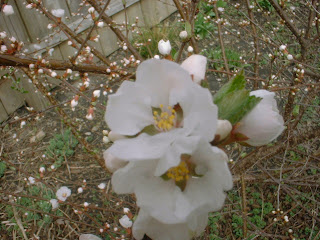
MYOPHILY (Fly pollination)
March weather is often cold and rainy. Not the kind of weather that you will find very many bees humming through a Chicago garden. So how do those plants that bloom so early manage. It seems trees are mostly wind pollinated but any insects so inclined may use the pollen they generate. Bulbs produce pollen and seed but have bulb division as a way to spread if seed production is inadaqute. And flies are handy pollinators available just about anytime of year.

After a long winter bees are looking for pollen as well as nectar. Pollen provides a protein source and nectar is a sweet carb. The protein content of pollen varies between 10 to 36%. In early spring when pollen sources are scare the less nutritional pollens may be used until richer fare becomes available. If this goes on too long nutritional deficiency may occur.

I went out into the garden to check the pollen supply of a couple of blooms. This powder like yellow smudge on my finger is from a daffodill.

This second picture of pollen from the Nanking cherry looks and feels more granular.

Access to the pollen was easy.

Good sources of early pollen include Maple,Elm,Redbud,willow,cedar,fruit bloom,henbit,and reliable dandelion.
Excerpt...
Myophily Fly Pollination
Flies (Dipterans) are among the most common insects that visit and pollinate flowers. Flies have been mentioned as pollinators or regular visitors of thousands of species of flowering plant. A great variation of pollination methods is found among the plants that are fly pollinated. Many of the pollinator flies feed on exposed fluids and also eat small solid particles including pollen grains. Flies are important pollinators under certain climatic conditions because they are present at all times of the year. Some plants may be completely dependent on flies for pollination. Even flies that are generalists in their floral visits can contribute to plant reproductive success, and may equal or rival bees as effective pollinators in some.
MYOPHILY (Fly pollination): In general, typical fly pollinated flowers do not bloom regularly and are simple with very little depth. Flower colour is usually pale with a dull texture. Nectar guides often occur. Nectar is open or easily available and the male and female parts of the flower are well exposed. Many of these flowers are scented, but for the most part, the scent is imperceptible.
The "hoverflies" are some of the most common pollinators flies, they are often brightly coloured they are also known as pollen eaters and visit tubular or convex shaped flowers. Adult flies feed on pollen and nectar.


0 Comments:
Post a Comment
<< Home